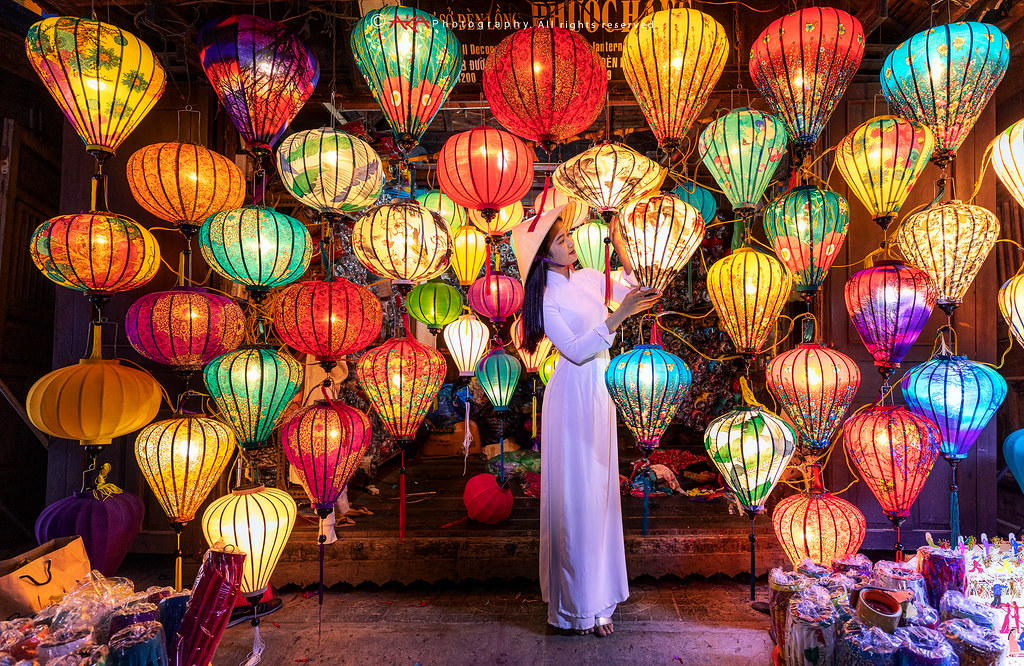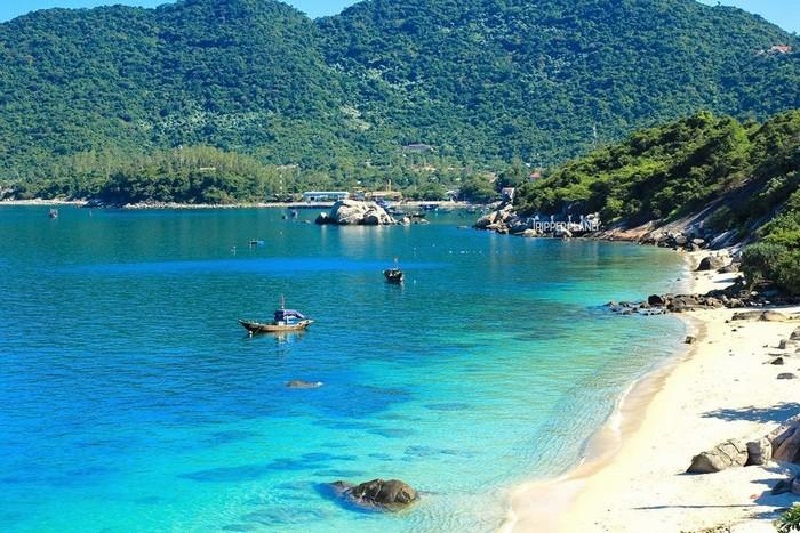Photo: Collected
Hoi An is an ancient town with long-standing cultural values. This place also possesses many poetic landscapes and attractive entertainment spots that are not inferior to Da Nang. If you don't know where to go in Hoi An, these 20 enchantingly beautiful Hoi An tourist destinations will give you an idea to explore.
In the previous section, we learned about some tourist destinations in Hoi An that are worth experiencing. This section will introduce to you tourist destinations that you should not miss when coming to Hoi An, as well as reveal to you some tips for a complete trip to Hoi An.
20 Hoi An tourist destinations that tourists should experience (part 2)
9. Lantern Street - sparkling check-in point
The colorful lanterns shining brightly in every corner of the sky have become an image associated with the old town every evening. No matter what time you come here, visitors can always admire the beauty of lanterns hanging everywhere.

Tourists coming to Hoi An are always delighted with the brilliant lanterns
Hoi An Lantern Street has become a famous check-in spot. Most tourists, especially young people coming to Hoi An would love to visit this street to admire the beauty and take photos.
Address: Nguyen Phuc Chu Street, Hoi An City.
10. Chaozhou Assembly Hall - Unique work of the Chinese people
For tourists who are passionate about exploring culture, Chaozhou Assembly Hall is an ideal destination. Chaozhou Assembly Hall, also known as Am Bon Pagoda is not only a place of belief and spirituality but is also where the Chaozhou community in Hoi An meet.

Currently, the hall is worshiping gods who control waves and winds. According to people here, if you pray sincerely, your sea trips will always go smoothly.
Address: 157 Nguyen Duy Hieu, Hoi An City
11. Ba Mu Pagoda
Dubbed the holy place of "million-like posts", Ba Mu Pagoda is constantly "hot" when young people rush here to check-in. With its elaborately carved golden wall and the clear lake surface reflecting the deep blue sky, everything is set up perfectly for taking pictures.

Not simply a place to take photos, Ba Mu Pagoda is also one of the famous relics that plays an important role in the spiritual life of local people and is considered a new symbol of Hoi An.
Address: 675A Hai Ba Trung, Hoi An City.
12. An Bang Beach - 1 of the 50 best beaches in the world
Hoi An tourism, in addition to heritage sites and ancient buildings, also has beautiful beaches. One of them is An Bang Beach. Located only about 3km from the old town center, An Bang is on the list of 50 beaches in the world.

Hoi An also offers enchanting beaches
With a length of only about 4km, but with pure nature, diverse vegetation, fine white sand, and clear blue water, this place is very suitable for beach trips and relaxation.
Address: Hai Ba Trung Street, Hoi An City.
13. Hoi An Folk Culture Museum
The Folklore Museum is a unique thematic museum in Hoi An, opening to serve visitors starting from March 24, 2005. This museum consists of 2 classical floors.

Inside, 490 artifacts are displayed with a variety of topics: folk art, performing arts, traditional professions, etc. Through this, visitors can better understand the process of building and developing Hoi An.
Address: 33 Nguyen Thai Hoc, Hoi An City
14. Tan Ky ancient house - National Cultural Heritage
Aged more than 200 years old, Tan Ky ancient house has been classified as a national relic. This house possesses unique architectural features with a blend of Japanese, Chinese, and Vietnamese architecture.

Hoi An has quite a few ancient houses and Assembly Halls worth a visit.
Built from traditional materials with many interconnected folds and many delicately carved miniatures and shapes, the houses still retain their old beauty even though it has been lived in for 7 generations.
Address: No. 1 Nguyen Thai Hoc, Hoi An City.
15. Cua Dai Beach - Hoi An's bustling beach
Also a beautiful, famous beach of Hoi An. Cua Dai Beach is an interesting destination not to be missed in the journey to explore the land of heritages.

Cua Dai always attracts tourists with its endless stretches of white sand surrounded by tall green coconut trees. Visitors can freely immerse themselves in the clear blue water or lie on the sand and enjoy fresh seafood dishes.
Address: Hoi An City, Quang Nam Province (about 5km from the ancient town).
16. Bay Mau coconut forest - Southwest Vietnam in the heart of the old town
This Hoi An tourist destination is located about 3km from the center of the old town. Dubbed "Southwest Vietnam in the heart of the old town", Bay Mau coconut forest offers many activities on the river that tourists would love to experience.
The feeling of riding a basket boat into the coconut forest, immersing yourself in the cool fresh air watching basket-boat dances, spreading nets to catch fish, and making your own souvenirs with coconut leaves will surely be memorable.
Address: Cam Thanh Commune, Hoi An City.
17. Tra Que Vegetable Village, Hoi An
Although not located in the center and not too prominent, Tra Que vegetable village is still a name that is difficult to ignore for those who love nature and want to experience the life of a farmer.

Not only is it famous for being a clean organic vegetable-growing village with all kinds of vegetables, Tra Que Vegetable Village is also a place for visitors to better understand the lives of the people through the activities of digging soil, growing vegetables, and watering them.
Address: Tra Que Village, Cam Ha, Hoi An.
18. Thanh Ha Pottery Village - Pottery craft village for more than 500 years
If you don't know where to go or what to do in Hoi An, go to Thanh Ha Pottery Village. Located on Thu Bon River, about 3km from the old town and has been around for more than 500 years, this place still retains the traditional pottery-making profession.

Stepping in here, visitors will be surprised by the unique ceramic products, the simple roofs covered with fired tiles, and even the burnt brick roads. Especially, right next door is the terracotta park - an extremely enchanting paradise.
Address: Pham Phan Street, Thanh Ha Ward, Hoi An City
19. Cu Lao Cham Island - the "Raw pearl" of Hoi An
Besides the beauty of the old town, beaches, and traditional craft villages, Hoi An also owns a beautiful, pristine island, Cu Lao Cham. This is also an attractive tourist destination of Hoi An and Da Nang and has been attracting more and more tourists.

Cu Lao Cham has attracted more international visitors to Hoi An
With many beautiful clear blue beaches, rich flora and fauna, a fresh climate, and many delicious dishes, the experience of traveling to Cu Lao Cham promises to be very interesting. Not only will you be able to swim in the sea, but you will also be able to dive to see the coral with your bare eyes.
Address: Tan Hiep commune, Hoi An, Quang Nam.
20. VinWonders Nam Hoi An
Another extremely famous place that combines sightseeing and fun that visitors should not miss is VinWonders Nam Hoi An. This tourist area is located only about 17km from the center of Hoi An ancient town. Divided into 5 separate areas, this place brings many exciting experiences for all ages.
Tourists and families coming here can comfortably explore the folk island, check in at the intersection, visit the zoo by the river, or enjoy the water park. Thrilling games are also extremely attractive and worth a try.
Address: Vo Chi Cong street, Binh Minh commune, Thang Binh district, Quang Nam.
The secret to a perfect trip to Hoi An
Hoi An is an ancient city that is not bustling, nor does it have high-rise buildings. It's so calm and gentle, but this place always has a strange attraction. Everyone who has come once will never forget it and want to come back a second or third time.
Tourists who come here and want to explore all the tourist attractions here should prepare a schedule of places to go, which points they should go to first, and which points can be conveniently combined along the way to save time.
In addition, visitors should also consider choosing appropriate and economical means of transportation while in the town. The ideal is riding a motorbike. And don't forget to pay attention to when you go, the dry season is always the best time to travel.
How to get to Hoi An?
There are many ways to travel to Hoi An from major provinces and cities. Below are some transportation options when departing to Hoi An from Ho Chi Minh City:
- Bus: takes about 20 hours and 30 minutes to go from Ho Chi Minh to Da Nang. It will then take another 1 hour to get to Hoi An.
- Train: takes about 17 hours to go from Ho Chi Minh to Da Nang. It will then take another 1 hour to get to Hoi An.
- Plane: takes about 1 hour and 20 minutes to go from Ho Chi Minh to Da Nang. It will then take another 1 hour to get to Hoi An.
- Motorbike: takes about 17 hours and 30 minutes to go from Ho Chi Minh to Hoi An. However, traveling by motorbike is a rather tiring choice. Please stop and rest a few stops if you travel by this means.
Source: www.hoianworldheritage.org.vn